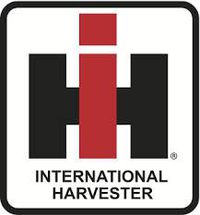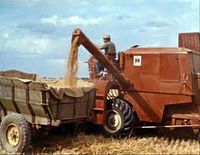Encyclopedia Dubuque
"Encyclopedia Dubuque is the online authority for all things Dubuque, written by the people who know the city best.”
Marshall Cohen—researcher and producer, CNN
Affiliated with the Local History Network of the State Historical Society of Iowa, and the Iowa Museum Association.
INTERNATIONAL HARVESTER COMPANY: Difference between revisions
No edit summary |
No edit summary |
||
| (21 intermediate revisions by the same user not shown) | |||
| Line 1: | Line 1: | ||
[[Image:INTH.jpg|left|thumb|250px|]]INTERNATIONAL HARVESTER COMPANY. | [[Image:INTH.jpg|left|thumb|250px|Distribution warehouse. Undated photo. Library of Congress.]] | ||
[[File:harvester1.jpg|200px|thumb|left|]]INTERNATIONAL HARVESTER COMPANY. Cyrus Hall McCormick decided to move to Chicago in 1847, when he and his partner Charles M. Gray built a reaper factory on the north bank of the Chicago River. McCormick's mechanical reapers (which required horses to pull) proved to be popular with farmers; the enterprise expanded steadily. By the middle of the 1850s, the Chicago plant manufactured more than 2,500 reapers a year, worth over $300,000. After the original plant burned in the 1871 fire, McCormick built a larger factory along the South Branch of the Chicago River. This facility soon employed about 800 men; annual sales well exceeded $1 million. (1) | |||
The | After Cyrus' death in 1884, his wife and his son took over the business. Hostile toward labor unions and their demands for an eight-hour workday, the McCormicks faced strikes by their workers in 1885 and 1886; the second of these was associated with the explosion of a bomb at Haymarket Square in Chicago. (2) | ||
In 1902, McCormick and Deering—along with the Plano Manufacturing Co. (which had about 1,400 workers at its West Pullman plant) and two smaller farm equipment makers—merged to form International Harvester. The new company was capitalized at $120 million and dominated the American market. For most of the twentieth century, International Harvester (IH) was one of the leading industrial corporations in the United States; its operations were concentrated in Chicago and its suburbs. (3) | |||
In 1903 International Harvester considered Dubuque as a distribution center. The company established a general agency in the city with offices and warehouse located on South Main. From here, farmers could obtain binding twice; harvesting, haying and tillage machinery; motor vehicles; manure spreaders; hay presses; gasoline engines and tractors; wagons; cream separators; threshers and other implements. (4) | |||
By 1910, when IH grossed about $100 million in annual sales, it had over 17,000 workers in the Chicago area, making it the leading employer in the region. By that time, IH had established its own steel mill on the city's far South Side, which it named Wisconsin Steel, as well as manufacturing plants in Sweden, Russia, and Germany. (5) | |||
A manufacturer of trucks as well as tractors, during the first years of the twentieth century the company moved away from animal-powered equipment and toward motorized vehicles. By the 1930s, as the nation's leading manufacturer of trucks, IH had a sales network of about 11,000 dealers across the country. In 1939 service men for the company's eighty-seven McCormick-Deering farm machinery dealers in the Dubuque district came to Dubuque for the annual two day service school. New improvements on the machinery would be explained along with a complete outline of company recommended methods of servicing the machinery. (6) | |||
During the 1950s, when annual sales passed $1 billion, John Deere surpassed IH as the nation's leading maker of agricultural equipment. By the 1970s, IH still employed about 20,000 people in the Chicago area and tens of thousands more around the world. But the company was beginning to struggle. (7) | |||
In 1957 the International Harvester franchise in Dubuque was purchased by Roeder Brothers, Inc. creating [[ROEDER IMPLEMENT INC.]] (8) | |||
[[File:harvester3.jpg|200px|thumb|left|]] | |||
Between 1977 and 1979, International Harvestor sold Wisconsin Steel to Envirodyne Inc. By the early 1980s, the company was losing huge amounts of money and chose to sell its farm equipment business (as well as the International Harvester name) to Tenneco Inc., a competitor. | |||
By 1986, most of what had been International Harvester became Navistar International Corp. By the end of the 1990s, Navistar, headquartered in suburban Warrenville, had become the nation's leading manufacturer of large trucks. It employed about 2,500 people in the Chicago area. Its total revenues in 2002 stood at almost $7 billion. (9) | |||
The 1904-1905 '''Dubuque City Directory''' located this business as Main south of Jones. | |||
The 1913 '''Dubuque and Dubuque County Directory''' through the 1918 '''Dubuque and East Dubuque City Directory''' stated that this business was located at 160-172 S. Main. | |||
The 1922 telephone directory listed 651 Central. | The 1922 telephone directory listed 651 Central. | ||
The | The 1923 '''Dubuque City Directory''' listed 525 [[BANK AND INSURANCE BUILDING]]. | ||
The 1934 '''Dubuque City Directory''' and the 1937 '''Dubuque Consurvey Directory''' listed 100 S. Main. | |||
The 1939 '''Dubuque Classified Business Directory''' through 1957 '''Dubuque Classified Business Directory''' listed 98-100 S. Main. (PICTURED) | |||
The 1974 '''Dubuque City Directory''' listed 8 Main. | |||
--- | |||
Source: | |||
1. "International Harvester," Wikipedia | |||
2. Ibid. | |||
3. Ibid. | |||
4. "International Harvester Company"-email from Paul Hemmer | |||
5. Wikipedia | |||
6. "Service School is Opened Here," ''Telegraph-Herald'', February 1, 1939, p. 15 | |||
7. Wikipedia | |||
8. Roeder Brothers (History). Online: https://www.roederbros.com/company-history.htm | |||
9. Wikipedia | |||
[[Category: Agricultural Implement Dealer/Manufacturer]] | [[Category: Agricultural Implement Dealer/Manufacturer]] | ||
[[Category: Gasoline Engines]] | [[Category: Gasoline Engines]] | ||
[[Category: Truck Dealers]] | [[Category: Truck Dealers]] | ||
[[Category: Auto Company]] | [[Category: Auto Company]] | ||
Latest revision as of 02:46, 28 August 2021
INTERNATIONAL HARVESTER COMPANY. Cyrus Hall McCormick decided to move to Chicago in 1847, when he and his partner Charles M. Gray built a reaper factory on the north bank of the Chicago River. McCormick's mechanical reapers (which required horses to pull) proved to be popular with farmers; the enterprise expanded steadily. By the middle of the 1850s, the Chicago plant manufactured more than 2,500 reapers a year, worth over $300,000. After the original plant burned in the 1871 fire, McCormick built a larger factory along the South Branch of the Chicago River. This facility soon employed about 800 men; annual sales well exceeded $1 million. (1)
After Cyrus' death in 1884, his wife and his son took over the business. Hostile toward labor unions and their demands for an eight-hour workday, the McCormicks faced strikes by their workers in 1885 and 1886; the second of these was associated with the explosion of a bomb at Haymarket Square in Chicago. (2)
In 1902, McCormick and Deering—along with the Plano Manufacturing Co. (which had about 1,400 workers at its West Pullman plant) and two smaller farm equipment makers—merged to form International Harvester. The new company was capitalized at $120 million and dominated the American market. For most of the twentieth century, International Harvester (IH) was one of the leading industrial corporations in the United States; its operations were concentrated in Chicago and its suburbs. (3)
In 1903 International Harvester considered Dubuque as a distribution center. The company established a general agency in the city with offices and warehouse located on South Main. From here, farmers could obtain binding twice; harvesting, haying and tillage machinery; motor vehicles; manure spreaders; hay presses; gasoline engines and tractors; wagons; cream separators; threshers and other implements. (4)
By 1910, when IH grossed about $100 million in annual sales, it had over 17,000 workers in the Chicago area, making it the leading employer in the region. By that time, IH had established its own steel mill on the city's far South Side, which it named Wisconsin Steel, as well as manufacturing plants in Sweden, Russia, and Germany. (5)
A manufacturer of trucks as well as tractors, during the first years of the twentieth century the company moved away from animal-powered equipment and toward motorized vehicles. By the 1930s, as the nation's leading manufacturer of trucks, IH had a sales network of about 11,000 dealers across the country. In 1939 service men for the company's eighty-seven McCormick-Deering farm machinery dealers in the Dubuque district came to Dubuque for the annual two day service school. New improvements on the machinery would be explained along with a complete outline of company recommended methods of servicing the machinery. (6)
During the 1950s, when annual sales passed $1 billion, John Deere surpassed IH as the nation's leading maker of agricultural equipment. By the 1970s, IH still employed about 20,000 people in the Chicago area and tens of thousands more around the world. But the company was beginning to struggle. (7)
In 1957 the International Harvester franchise in Dubuque was purchased by Roeder Brothers, Inc. creating ROEDER IMPLEMENT INC. (8)
Between 1977 and 1979, International Harvestor sold Wisconsin Steel to Envirodyne Inc. By the early 1980s, the company was losing huge amounts of money and chose to sell its farm equipment business (as well as the International Harvester name) to Tenneco Inc., a competitor.
By 1986, most of what had been International Harvester became Navistar International Corp. By the end of the 1990s, Navistar, headquartered in suburban Warrenville, had become the nation's leading manufacturer of large trucks. It employed about 2,500 people in the Chicago area. Its total revenues in 2002 stood at almost $7 billion. (9)
The 1904-1905 Dubuque City Directory located this business as Main south of Jones.
The 1913 Dubuque and Dubuque County Directory through the 1918 Dubuque and East Dubuque City Directory stated that this business was located at 160-172 S. Main.
The 1922 telephone directory listed 651 Central.
The 1923 Dubuque City Directory listed 525 BANK AND INSURANCE BUILDING.
The 1934 Dubuque City Directory and the 1937 Dubuque Consurvey Directory listed 100 S. Main.
The 1939 Dubuque Classified Business Directory through 1957 Dubuque Classified Business Directory listed 98-100 S. Main. (PICTURED)
The 1974 Dubuque City Directory listed 8 Main.
---
Source:
1. "International Harvester," Wikipedia
2. Ibid.
3. Ibid.
4. "International Harvester Company"-email from Paul Hemmer
5. Wikipedia
6. "Service School is Opened Here," Telegraph-Herald, February 1, 1939, p. 15
7. Wikipedia
8. Roeder Brothers (History). Online: https://www.roederbros.com/company-history.htm
9. Wikipedia




